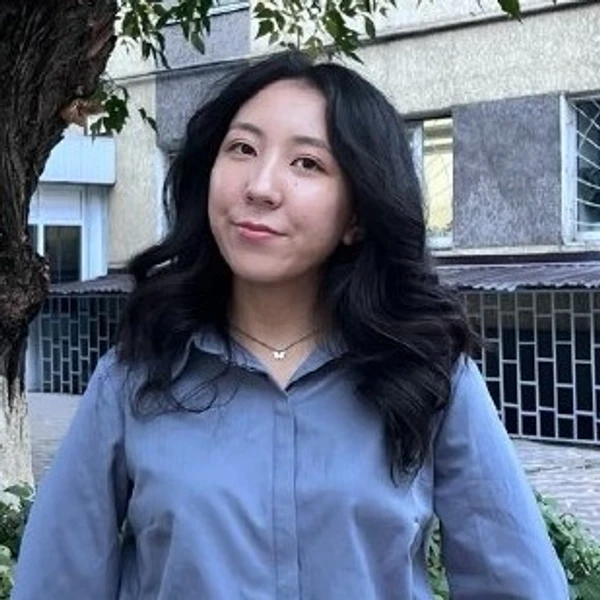
Hobbies and interests
3D Modeling
Art
Alpine Skiing
Advertising
Collaging
Business And Entrepreneurship
Reading
Speech and Debate
Ecology
Sustainability
Costume Design
Nordic Skiing
Art History
Reading
Academic
Adventure
Art
Design
Environment
Education
Aiym Samatova
925
Bold Points1x
Finalist
Aiym Samatova
925
Bold Points1x
FinalistBio
In Kyrgyzstan, fashion became my way to link creativity with social impact. Through Fashion Revolution, I organized workshops and the “Who Made My Clothes” exhibition, opening conversations about sustainability and transparency. I launched “From Tradition to Innovation”, training 50+ teachers and inspiring 200+ entrepreneurs, while with Enactus I led an eco-project that cut waste by 40% and reached 400+ rural students.
My collections — including a socially themed line at an Eco Fashion Show and an installation in Istanbul — reflect my belief that clothing can tell stories and spark change. I aim to create a hub of sustainable design and entrepreneurship in Central Asia, scaling projects that unite tradition with innovation.
Education
Drexel University
Bachelor's degree programMajors:
- Apparel and Textiles
- Community/Environmental/Socially-Engaged Art
- Business, Management, Marketing, and Related Support Services, Other
Minors:
- Sustainability Studies
- Visual and Performing Arts, General
- Social Sciences, General
Miscellaneous
Desired degree level:
Master's degree program
Graduate schools of interest:
Transfer schools of interest:
Majors of interest:
- Environmental/Natural Resources Management and Policy
- Business, Management, Marketing, and Related Support Services, Other
- Marketing
- Communication, Journalism, and Related Programs, Other
- Apparel and Textiles
- Sustainability Studies
Career
Dream career field:
Apparel & Fashion
Dream career goals:
Fasion Product Managment , Founder of a sustainable fashion brand
Project Manager and Teacher (Owner)
Enactus — E-Club & E-Cup Projects (My own project)2022 – 20242 yearsTeam Lead / CLO3D Designer
The Dress Code/UDCLO (Digital Fashion Hackathon Project)2023 – Present2 yearsCountry Ambassador (Kyrgyzstan)
Fashion Revolution2024 – Present1 yearMarketing and Sales Strategist Project Manager
Toolor (International Functional Outerwear Brand)2022 – 20242 years
Sports
Alpine Skiing
Intramural2013 – Present12 years
Research
Environmental/Natural Resources Management and Policy
Fashion Revolution — Research Lead / Country Ambassador (Kyrgyzstan)2023 – Present
Arts
International Eco Fashion Event
DesignMy oown sustainable fashion collection2024 – 2025Independent Project & Local Fashion Show
DesignInstallation Artist - "Gold vs Bread"2024 – 2024International Exhibition at Bül Feshane Museum, Istanbul
Visual ArtsInstallation Artist — “Gold vs Bread”2023 – 2024
Public services
Public Service (Politics)
Model United Nations Association of Kyrgyzstan — Delegate & Policy Drafting Participant2023 – 2024Volunteering
EMS Educational Exhibition — Event Volunteer & Coordinator Assistant2023 – 2023Volunteering
Enactus E-Club & E-Cup — Project Manager & Team Leader2023 – 2024Volunteering
CEO & Project Lead — “From Tradition to Innovation” — CEO & Training Organizer2024 – PresentAdvocacy
Fashion Revolution — Project Lead & Exhibition Curator2023 – 2024
Future Interests
Advocacy
Politics
Volunteering
Philanthropy
Entrepreneurship
Ultrafabrics Inc. Scholarship Award
2,700 liters. What comes to mind immediately? Wow — that’s enough water to sustain me for 900 days, take 30 baths, or even water entire fields. So many possibilities! But who would have thought that 2,700 liters of water would remind me of… a T-shirt. Yes, just a regular white T-shirt that almost everyone owns.
That number was my wake-up call. It made me see clothes differently — not just as fabric and stitches, but as stories of resources, labor, and impact. This curiosity led me to join the Fashion Revolution campaign and its Who Made My Clothes movement. I organized awareness events, shared information online, and spoke to local communities about the hidden journey of garments — from fiber cultivation to final sale. I saw how little people knew about their clothes’ origins, and how powerful it was to connect them to the makers and the environmental cost behind each piece.
During this time, I began reflecting on my own heritage. I grew up in the mountains of Kyrgyzstan, where my family kept large flocks of sheep. My grandmother bred fine sheep with high-quality wool, and every shearing season our yard filled with soft fibers. But alongside the valuable wool was always a pile of coarse, short fibers — “unusable” wool that no one wanted. We often burned it. Watching this felt wrong. For centuries, wool had been woven into our homes, clothes, and traditions. Now, part of that heritage was being discarded as waste.
This became the starting point for Smart Wool — my project to transform low-grade wool into a high-performance, sustainable textile. Through a process I developed — enzymatic shrink-proofing, structural densification, eco-friendly PFC-free DWR coating, and blending with biopolyamide — I can preserve up to 58% of wool that would otherwise be thrown away. The result is a material that’s 30% warmer, 15% stronger, and 67% more abrasion-resistant than untreated wool, while remaining natural. Processing just 50 tons annually could save 30+ tons of CO₂ emissions and prevent wasting thousands of cubic meters of water used to produce new fibers.
To bring Smart Wool into modern design workflows, I integrated CLO3D into my process. This tool lets me create lifelike prototypes, test how Smart Wool behaves in different designs, and cut physical samples by half — reducing waste, speeding production, and improving resource use.
I have already created three digital prototypes from Smart Wool:
Insulated jacket — showcasing water-repellent and windproof qualities.
Classic coat — highlighting thermal insulation and premium look.
Casual sweatshirt — demonstrating comfort and everyday wearability.
For me, sustainability is about closing the loop — from raw fiber to final garment — and ensuring that no resource, tradition, or story is lost. By combining cultural heritage with technological innovation, I want to show that sustainable design can protect traditions, empower communities, and inspire global change. Smart Wool is my proof that what was once considered waste can become the fabric of the future.